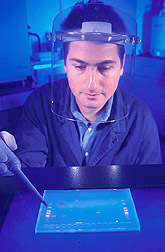This page has been archived and is being provided for reference purposes only. The page is no longer being updated, and therefore, links on the page may be invalid.
|
|
Proposal to Shake Down Protozoans Wins Top AwardBy Rosalie Marion BlissNovember 14, 2002 Agricultural Research Service scientist Benjamin M. Rosenthal has won the agency's T.W. Edminster Research Associate Award for the top-ranked proposal for the ARS 2003 Postdoctoral Research Associate Program. Rosenthal and colleagues at the ARS Parasite Biology, Epidemiology and Systematics Laboratory in Beltsville, Md., have been working to discern how similar parasitic species are related to one another and how to tell them apart. These parasites include Neospora, Hammondia, Besnoitia and Sarcocystis, which form cysts in the muscles of certain animals, wildlife and even people. Rosenthal proposed to compare how genetically variable these parasite species are to Toxoplasma gondii, a parasite threatening the health of pregnant women and immuno-compromised persons. The work will help define the risk to human health posed by such related parasites. ARS, the chief scientific research agency of the U.S. Department of Agriculture, allocated $4 million to fund 50 projects, which were selected from 434 proposals submitted. Each ARS project scientist awarded will recruit a qualified postdoctoral research associate for two years to help solve agricultural problems critical to the national agenda. Other winning proposals include:
|

